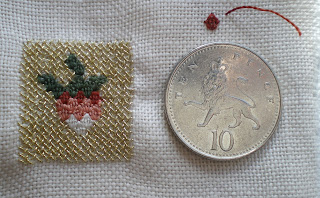In the days leading up to the wedding I tried to maintain my schedule of doing a little stitching before leaving for work. On one level, it keeps my current stitching project moving along but more importantly, stitching time is me time. It sounds terribly indulgent, but it has become very important for me to take a little time each day that is purely about what I want to be doing.
With Jon leaving early for work I was able to fit in an hour stitching some mornings and made good progress. When I finally packed away my frame in the big clean up before the wedding I had completed the couching. Things like this are important to me. I would have been uncomfortable putting my stitching away if I had not reached a satisfactory break point.

© JEC/Carol-Anne Conway
It was more than a week before I set up my frame again but for once I didn't miss it too much ;-)
The spaces between the couched lines are filled with
Tataki-ume - one or two beads placed at different angles without space between the them. RANDOM!
My brain is not wired for random; when faced with random it tries to establish a method.
My first 'method' involved stitching 2 beads into the center, then stitching two more beads at an angle (not quite 90 degrees) to the first two beads. I continued to stitch 2 beads at an angle to the previous beads when ever possible and in filling with single beads where two would not fit. This method seemed to work well, although I ended up stitching with 1 bead, rather than 2, more often than not.

© JEC/Carol-Anne Conway
My second 'method' was to stitch six beads around a single central bead to form a hexagon, then to stitch more 'hexagons' around the original. This began well but I very soon found it difficult to work out where the next hexagon should be and could see regular rows developing.

© JEC/Carol-Anne Conway
My third 'method' was not really a method at all. While stitching, I envisaged my beads floating along in a stream. In many places the stream flows smoothly and the beads align themselves with the flow; orderly, regular and calm. In other places there are rocks below the surface that alter the coarse of the stream creating eddies and ripples. In this disturbed water the beads struggle to maintain their order, occasionally new patterns emerge and then disintegrating back into chaos. This is random. I thought these thoughts and stitched the beads were I felt they needed to be. Very zen, don't you think.

© JEC/Carol-Anne Conway
Well, I think that it worked! Maybe, finally I'm beginning to understand random.

© JEC/Carol-Anne Conway
Happy Stitching























